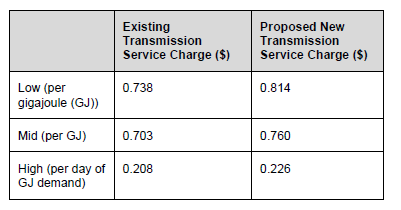Rate Rider – Tariff
ATCO Gas, a division of ATCO Gas and Pipelines Ltd. (“ATCO”) applied for approval of its 2016 transmission service charge (“Rider T”), to be effective on March 1, 2016 as follows:
ATCO submitted that NOVA Gas Transmission Ltd. (“NGTL”) received approval for the interim rates, tolls and charges for the Alberta system from the National Energy Board in November 2015. The FT-D3 (intra-Alberta delivery) rate increased to $6.09 per GJ/month, from $5.46 per GJ/month, while the abandonment surcharge was decreased from $0.33 per GJ/month to $0.32 per GJ/month.
ATCO submitted that it calculated the 2016 Rider T amount as the FT-D3 rate charged to ATCO by NGTL, multiplied by the contract demand (“CD”) quantity, and the NGTL abandonment surcharge amount, multiplied by the CD quantity. ATCO also included amounts to true-up the amount of 2015 revenue collected and revenues collected for Rider T in January and February 2016.
The AUC noted that prior to Decision 2014-062 dealing with Rider T, separate rates were ordered for north and south service areas in Alberta. In Decision 2014-062, the AUC found that the level of cross-subsidization between customer bases was immaterial, at less than $2 per customer on an annual basis. The AUC ordered ATCO to provide an analysis of whether to continue the practice of levying separate Rider T rates to the north and south service areas in ATCO’s next application for Rider T.
ATCO submitted that, if north and south Rider T rates were calculated separates, customers in northern Alberta would see an increase of $3.92 per year on a typical bill, while southern Alberta customers would see a $4.16 decrease in the per year on a typical bill.
The AUC found that the level of cross subsidization, being a $3.92 subsidy from customers in the north, offset by a $4.16 cost to customers in the south, was not material, and approved the Rider T charges as filed.
The AUC found that the proposed province-wide Rider T rates would provide lower costs for northern Alberta users than if Rider T was calculated separately. The AUC also made note that this was the third year in which a province wide Rider T was applied, and also the third year in which southern service area customers have subsidized the costs of northern service area customers. The AUC further noted that the level of cross-subsidization has increased with each subsequent year.
Given the ongoing cross-subsidization, the AUC directed ATCO to track the level of cross-subsidization and present that information with its next Rider T application.
The AUC determined that, if in ATCO’s next Rider T application, the subsidy from southern service area customers to northern service area customers exceeds the $4.16 annual amount approved in this decision, ATCO must provide a detailed analysis of how each of the billing determinants contributes to the level of cross-subsidization, and to investigate any other potential causes of cross-subsidization. Accordingly, the AUC also directed ATCO to explain, in its next Rider T application, to explain why the continued use of a province-wide rate would or would not be in the public interest.




